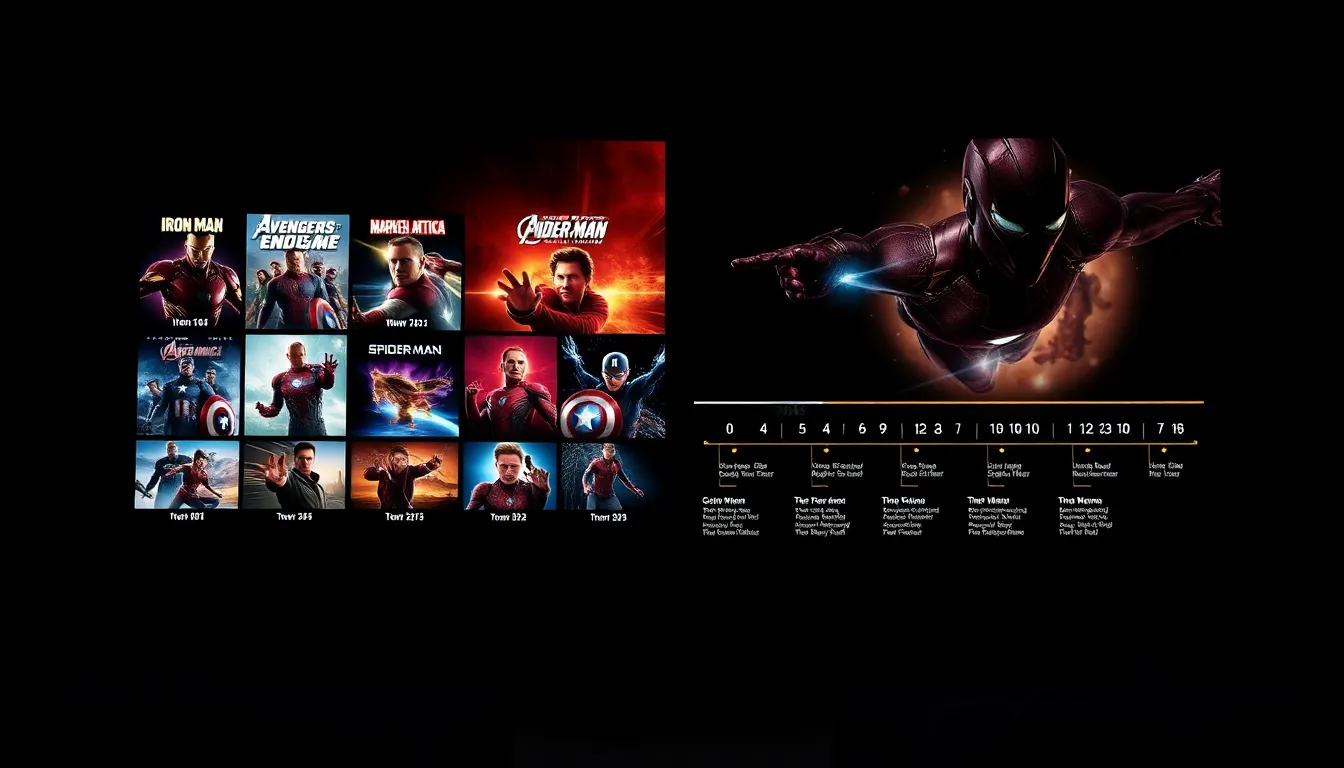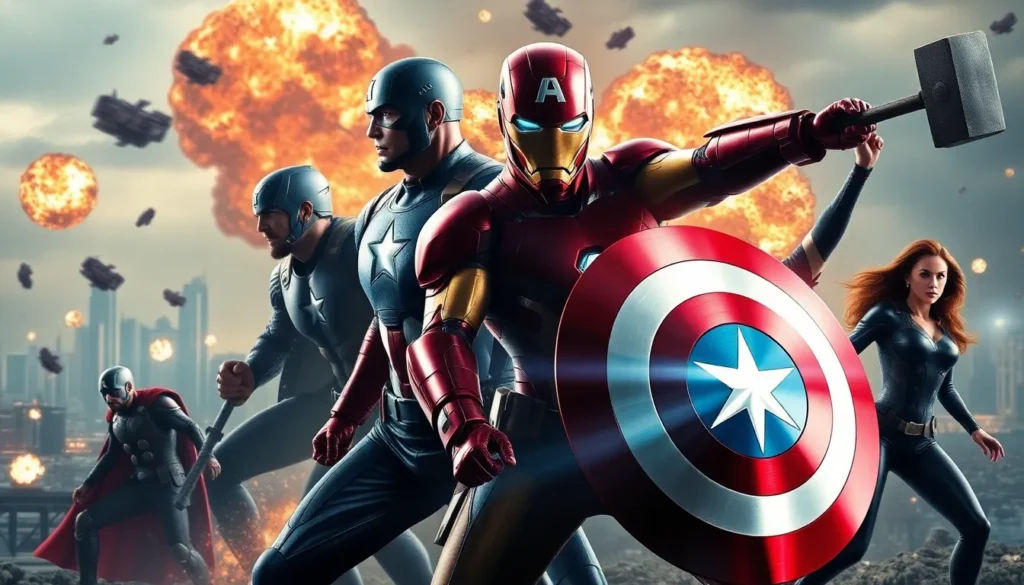Table of Contents
ToggleThe Avengers have taken the world by storm, assembling a fanbase that spans generations. With epic battles, unforgettable characters, and enough explosions to make a fireworks show blush, it’s no wonder everyone wants in on the action. But diving into the Marvel Cinematic Universe can feel like trying to solve a Rubik’s Cube blindfolded.
Understanding The Marvel Cinematic Universe
The Marvel Cinematic Universe (MCU) consists of interconnected films and television series. These productions create a unique tapestry of storytelling. Released in phases, each phase introduces new characters and expands on existing ones. Understanding the timeline facilitates a more enjoyable viewing experience.
Key characters play pivotal roles throughout the MCU. Iron Man, Captain America, Thor, and Black Widow consistently appear in various story arcs. Their journeys highlight themes of heroism, friendship, and sacrifice. Each installment builds on character development, making watching in order essential for following narrative threads.
Films such as “Iron Man” (2008) and “The Avengers” (2012) serve as the foundation for the MCU. They establish the universe’s tone and interconnected nature. Subsequent films, like “Guardians of the Galaxy” and “Black Panther,” introduce diverse heroes and enrich the storyline, catering to different audiences.
Not only do the films feature explosive action, but they also incorporate humor and emotional depth. Each genre shift within the MCU—from action to science fiction to drama—keeps viewers engaged. The pop culture impact of the MCU is significant, influencing various media formats and sparking discussions about heroism and responsibility.
Staying updated on upcoming releases enhances appreciation for the MCU. New projects expand the universe and further develop characters. Fans are encouraged to explore multiple platforms, including streaming services, to access films and series seamlessly.
MCU’s intricate design invites both casual viewers and devoted fans to become immersed. By understanding this vast universe, enjoyment multiplies and speculation increases, ensuring an engaging viewing experience.
Release Order Vs. Chronological Order

Viewing the Avengers can follow two main approaches: release order and chronological order. Each method offers different experiences, catering to diverse preferences.
Release Order Explained
Release order involves watching films as they premiered in theaters. Starting with “Iron Man” (2008), the journey begins with the introduction of Tony Stark and the establishment of the MCU. Following the initial film, viewers move to “The Incredible Hulk” (2008) and continue through subsequent titles, including “The Avengers” (2012). This approach preserves the way audiences experienced the unfolding story, revealing character developments and plot twists in the same order as they were intended. Fans appreciate this method for its historical context and the excitement surrounding each film’s release.
Chronological Order Explained
Chronological order focuses on the timeline within the MCU, skipping to the story’s events rather than release dates. Starting with “Captain America: The First Avenger” (2011), it showcases the events of World War II. Following the initial film, viewers progress through the timeline, incorporating titles like “Captain Marvel” (2019), which expands on earlier events. Presenting the story in sequence enhances the understanding of character relationships and plotlines. This method appeals to those seeking a coherent narrative experience, revealing connections among characters and events explicitly.
The Films In Order
Viewing the films in the Marvel Cinematic Universe (MCU) highlights the intricate connections between characters and story arcs. Familiarizing oneself with the order enhances appreciation for the narrative.
Phase One
Phase One introduces the core Avengers. It starts with “Iron Man” (2008), establishing Tony Stark’s journey. “The Incredible Hulk” (2008) follows, showcasing Bruce Banner’s struggle. “Iron Man 2” (2010) expands on Stark and his growing challenges. “Thor” (2011) brings in the Asgardian god into the fold. “Captain America: The First Avenger” (2011) depicts Steve Rogers’ transformation into a hero. Finally, “The Avengers” (2012) unites these characters, setting the stage for future conflicts.
Phase Two
Phase Two continues the adventure with deeper character exploration. “Iron Man 3” (2013) challenges Stark’s identity after the New York battle. “Thor: The Dark World” (2013) introduces an ancient enemy. “Captain America: The Winter Soldier” (2014) sees Rogers confront a conspiracy within S.H.I.E.L.D. “Guardians of the Galaxy” (2014) introduces new heroes in a cosmic setting. “Avengers: Age of Ultron” (2015) assembles the team against a robotic threat. It concludes with “Ant-Man” (2015), adding a new hero to the roster.
Phase Three
Phase Three expands the MCU with significant developments. “Captain America: Civil War” (2016) divides the Avengers over registration. “Doctor Strange” (2016) introduces the mystic arts and a new hero. “Spider-Man: Homecoming” (2017) reintegrates Spider-Man into the MCU. “Thor: Ragnarok” (2017) redefines Thor’s narrative with humor and action. “Black Panther” (2018) showcases Wakanda’s impact on the MCU. “Avengers: Infinity War” (2018) presents a monumental confrontation against Thanos. It wraps up with “Ant-Man and The Wasp” (2018), further intertwining plotlines.
Phase Four
Phase Four introduces fans to new directions and characters. “WandaVision” (2021) merges sitcom themes with deeper emotional narratives. “The Falcon and the Winter Soldier” (2021) explores legacy and identity. “Loki” (2021) delves into alternate realities and timelines. “Black Widow” (2021) investigates Natasha Romanoff’s past. “Shang-Chi and the Legend of the Ten Rings” (2021) presents martial arts and mythology. “Eternals” (2021) expands the cosmic scope. “Spider-Man: No Way Home” (2021) bridges multiverse concepts while “Doctor Strange in the Multiverse of Madness” (2022) deepens the exploration of alternate realities.
Additional Viewing Options
For a deeper exploration of the Marvel Cinematic Universe, viewers can check out additional content that expands on the main films.
Marvel One-Shots
Marvel One-Shots are short films released alongside various DVD and Blu-ray editions. These brief segments provide extra context and character development. Notable examples include “The Consultant,” which showcases Agent Coulson’s interactions with other characters. Another favorite, “Item 47,” features a couple using alien technology, further enriching the MCU’s lore. Fans appreciate these added layers, as they enhance the overall story.
Spin-Off Series
Spin-off series add more depth to the MCU and allow viewers to dive into character backstories. Examples include “Agents of S.H.I.E.L.D.,” which chronicles the organization’s secretive missions after “The Avengers.” “WandaVision” explores the complexities of Wanda Maximoff and the impact of grief. Another series, “Loki,” follows the God of Mischief’s adventures, showcasing his compelling character evolution. Each series introduces new elements while maintaining connections to the films, making them invaluable for dedicated fans.
Watching the Avengers in order offers an enriching experience that deepens appreciation for the Marvel Cinematic Universe. Whether choosing release order or chronological order each method enhances the storytelling and character development. The intricate connections between films and series invite viewers to explore themes of heroism and sacrifice while enjoying thrilling action and humor.
With each phase introducing new characters and narratives the journey through the MCU becomes an adventure in itself. By staying updated on upcoming releases fans can continue to immerse themselves in this captivating universe. The excitement of the MCU is sure to resonate with both new viewers and long-time enthusiasts alike.







